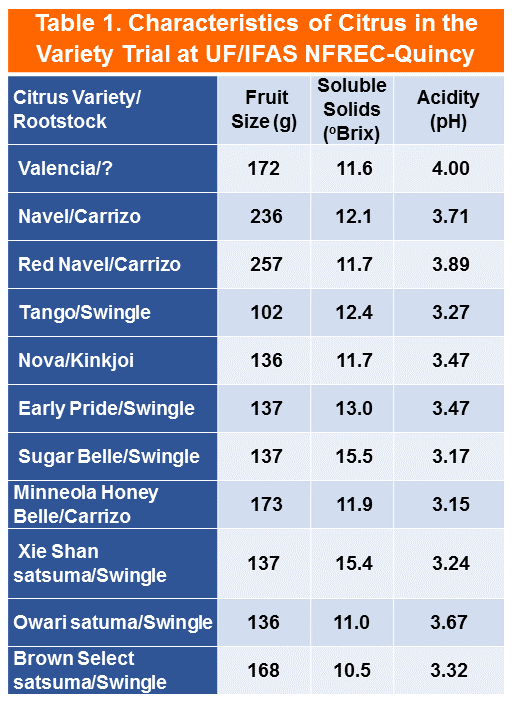
The relatively mild winter temperatures during the last two decades has led to a resurgence of interest in cold hardy citrus in North Florida. Satsumas account for almost all of the new commercial citrus acreage in the Florida Panhandle. Satsumas are the most cold-hardy commercial citrus. In North Florida, Satsuma fruit are ripe for harvest in a four to six week window from late October through early December. They must be hand clipped harvested to prevent tearing the peel and handled with care, because they are more prone to bruising than most other types of citrus. More than 100 new acres of Satsumas have been plated in Gadsden county alone, so it is important to identify some other varieties of citrus that are adapted to the region to offer a wide range of harvest date options.
If the next two decades have mild winter temperatures like the last two decades, we can successfully grow other cold-hardy citrus for the fresh market. The coldest temperature recorded at the NFREC-Quincy for the winters of 2015/2016 and 2016/2017 was 26° F. We have had temperatures as low as 15 and 16° F, and our older mature trees (satsuma, Navel, Minneola Honey Belle, and Valencia) have not experienced severe damage. A disclaimer, of course, should be noted that devastating freezes may still occur, despite this era of climate change and recent record warm temperatures.
The citrus varieties that ripen before Christmas probably have the best chance for success in North Florida. At the Research Center in Quincy, we have many citrus species/varieties and numbered selections under evaluation.The following is a list of the named varieties being evaluated. Table 1 at the end provides some preliminary data regarding the difference in fruit quality of these different varieities.
- Valencia: Although we have had good crops the last two years, I cannot recommend it for north Florida because of a late (late Jan. thru March) ripening date. In addition, other fresh market citrus offer more potential. There is also a new early ripening Valencia that we have not yet tested. The data in Table 1 reflect fruit that were not quite ripe.
- Navel and Red Navel: Navels have performed very well. I would estimate that our 12 year old trees have produced 400+ lbs per tree this winter. Little or no problem with Alternaria or citrus scab diseases. Our young trees also seem to be moderately cold hardy as well. Navel should be under consideration for north Florida. Harvest time can be just before Christmas.
- Tango: Tango is a seedless Murcott, although many fruit have a few (< 5 seeds per fruit when grown in a mixed block. Tango produces a small but sweet fruit. It is easy to peel. Cold tolerance is moderate. The two disadvantages are a late ripening period (Jan.) and extreme susceptibility to citrus scab.
- Nova: Nova mandarin was derived from a Clementine x Orlando Tangelo cross. It produces a small-medium sized fruit. Maturation is late January. It appears to be moderately cold hardy. More information is needed.
- Early Pride: Early Pride is low seeded Fallglo. It is an early maturing Mandarin hybrid. It produces a high quality, small-to medium-sized fruit with good flavor. It is easy to peel. Unfortunately, it is the least cold hardy (severe damage below 25 to 26 °F) of all the citrus that we have in our collection, and it cannot be recommended for north Florida.
- Sugar Belle: Sugar Belle was derived from a Clementine x Minneola Honey Belle cross. This mandarin hybrid is perhaps the most cold hardy of all non-satsumas in our trial. It produces a very attractive, bell-shaped fruit that is very high in sugar. It also is slightly higher in acid than is optimal. Fruit can have quite a few seeds when grown in a mixed block with citrus that can serve as pollinizers. Ripening date is November thru December. Sugar Belle could be considered for north Florida.
- Minneola Honey Belle: Minneola is an older cultivar that produces an attractive, medium-large, bell shaped fruit. It is less cold hardy than Sugar Belle and has a later ripening time period (late December). Minneola is very susceptible to Alternaria fungus, and a spray program is required for commercial production.
- Xie Shan: Xie Shan is an early ripening satsuma variety that ripens during October. In previous years Xie Shan has produced large, bumpy fruit that were not suitable for marketing. This year they produced a heavy crop (300 pounds/tree) of sweet, moderate-sized fruit. More observations are needed before I can recommend this variety.
- Owari: Owari is the most popular satsuma variety. It produces a consistent crop of small to medium-sized fruit. Owari and all satsumas are cold hardy down to about 12 to 14°F if the trees are cold acclimated. Ripening date is mid-November. It has performed well on Swingle and trifoliate orange rootstocks.
- Brown Select: Brown Select is the satsuma variety that produces the largest tree and fruit size. It ripens between between Xie Shan and Owari (early November). It has performed well on Swingle and trifoliate orange rootstocks.
For information on our long-term satsuma block, please refer to the UF/IFAS publication The Satsuma Mandarin. The performance of the experimental numbered selections will be dealt with in the future.

 0
0
